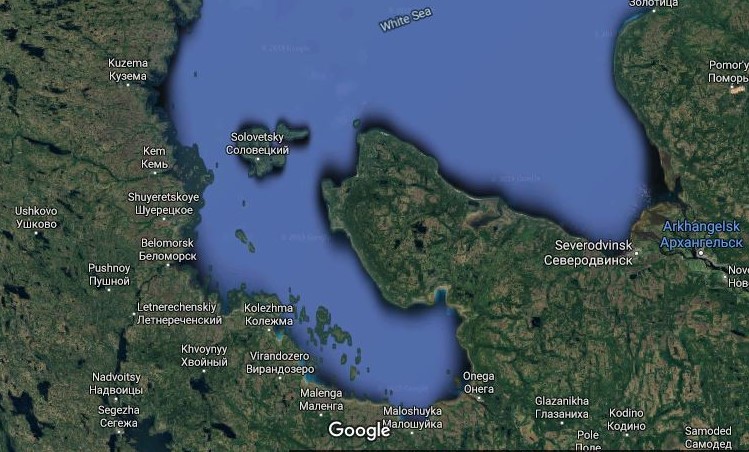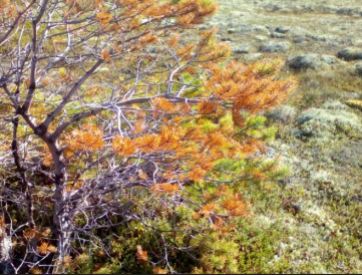“Really Frightening”: Trees Dry Up and Toadstools Vanish in Karelia After Explosion near Severodvinsk
Guberniya Daily
August 22, 2019
Residents of Karelia’s Kem District have sounded the alarm. Tree in the district have turned yellow and mushrooms have disappeared after the explosion near Severodvinsk, they claim.
“Ten days after [the accident], the vegetation on the islands in the White Sea near the settlement of Rabocheostrovsk took on a very unhealthy appearance. I get the impression the trees, grass, and moss burned flamelessly. Even toadstools and fly agaric, habitues of these locales, have disappeared on the islands. I would like you to clarify whether any tests will be made, what the republic’s government plans to do in general in response to this issue, and how people’s health will be affected,” a user identified as “Irina Kudryashova” wrote in a letter to Karelian Governor Arthur Parfenchikov, which she also posted on the VK wall “City of Kem Public Oversight.“
Kudryashova posted the following photos to back up her claims. She also posted a short video entitled “Yak Island Today August 18, 2019.”
In the same thread, someone identified as “Galina Ivankova” wrote that she was “really frightened.”
“Some men from Belomorsk went out to sea, but when they got to Shuyiretskoye there were warships at anchor there and a yellow cloud overhead. They got turned back: they weren’t allowed to go out into the sea. So welcome to Chernobyl Karelia. Thanks to the mad nuclear scientists,” a person identified as “Oleg Bachanov” wrote in another discussion on the same wall.
“The situation is the same on Yak Island: everything withered and dried in no time. In recent years, especially after 2009, I have noticed that, from the north and the northeast, all the woods and grass on the islands look as if they have been covered in brown paint. There are no berries or mushrooms in these patches,” replied a user identified as “Sandro Avtushenko.”
On August 8, a liquid rocket propulsion system exploded during testing on an offshore platform in the Arkhangelsk Region. Eight Rosatom employees [sic] were hurt; five of them were killed. Fearing radiation, residents of Severodvinsk and Arkhangelsk made a run on iodine in pharmacies.
After the explosion, radiation levels were sixteen times higher than normal in Severodvinsk. Higher levels of background radiation were also recorded in Norway a week after the blast.
Translated by the Russian Reader. NB. The original text was heavily edited to reflect the fact that the claims cited in the article were made by four discrete users on a VK community wall in Kem, Republic of Karelia, not by an indefinitely large number of “residents.”
 The area of Northwest Russia, encompassing parts of the Republic of Karelia and Arkhangelsk Region, discussed in the article. Image courtesy of Google Maps
The area of Northwest Russia, encompassing parts of the Republic of Karelia and Arkhangelsk Region, discussed in the article. Image courtesy of Google Maps
______________________________________
Putin Says No Radiation Threat from Recent Explosion, But Mum on Details of Accident
The Associated Press (via CBC News)
Aug 21, 2019
Russian President Vladimir Putin insisted Wednesday that a recent deadly explosion at a military testing site in northwestern Russia hasn’t posed any radiation threat, but he remained coy about the circumstances of the mysterious incident.
Speaking after talks in Helsinki with Finnish President Sauli Niinisto, Putin emphasized that neighboring nations haven’t recorded any spike in radioactivity.
“These are the objective data,” he said. “These things can be tracked.”
The Aug. 8 incident at the Russian navy’s range in Nyonoksa on the White Sea killed two servicemen and five nuclear engineers. It was followed by a brief rise in radiation levels in nearby Severodvinsk, but the authorities insisted the recorded levels didn’t pose any danger to local residents.
Russian officials’ changing and contradictory accounts of the incident drew comparisons to Soviet attempts to cover up the 1986 explosion and fire at the Chernobyl nuclear power plant in Ukraine, the world’s worst nuclear disaster.
The Russian Defense Ministry at first denied any radiation leak in the incident even as the authorities in nearby Severodvinsk reported a brief rise in radiation levels and advised residents to stay indoors and close the windows. Frightened residents rushed to buy iodine, which can help reduce risks from exposure to radiation.
Russia’s state weather and environmental monitoring agency said the peak radiation reading in Severodvinsk on Aug. 8 was 1.78 microsieverts per hour in just one neighborhood, about 16 times the average. Peak readings in other parts of Severodvinsk varied between 0.45 and 1.33 microsieverts.
The announced peak levels were indeed lower than the cosmic radiation that plane passengers are exposed to on longer flights or doses that patients get during some medical scans.
No detail on weapon tested
The Comprehensive Nuclear Test Ban Treaty Organization (CNTBTO) said earlier this week that several Russian radiation monitoring stations went silent shortly after the explosion in Nyonoksa. Lassina Zebro, the organization’s executive secretary, said Tuesday that the two Russian stations reported to be offline were back in operation and are now backfilling the data.
Observers said that several stations coming offline at the same time appeared to reflect a coordinated effort to conceal the radiation data, which could help identify the technology that was being tested at the time of the explosion.
Putin hailed the victims, saying they were doing “very important work for the nation’s security,” but kept mum on what type of weapon they were testing.
Russia’s state nuclear corporation Rosatom said the explosion occurred on an offshore platform during tests of a “nuclear isotope power source” for a rocket engine, a statement that led some experts to conclude that the weapon undergoing tests was the Burevestnik (Storm Petrel), a prospective nuclear-powered cruise missile first mentioned by Putin in 2018 that was code-named Skyfall by NATO.
U.S. President Donald Trump has backed that theory in a tweet, saying that the U.S. is “learning much” from the deadly explosion. In a tweet, he said, “The Russian Skyfall explosion has people worried about the air around the facility, and far beyond. Not good!”
The U.S. worked to develop a nuclear-powered missile in the 1960s under Project Pluto, but abandoned the technology as too unstable and risky.
Discover more from The Russian Reader
Subscribe to get the latest posts to your email.






One thought on ““Really Frightening”: Trees Dry Up and Toadstools Vanish in Karelia After Explosion near Severodvinsk”